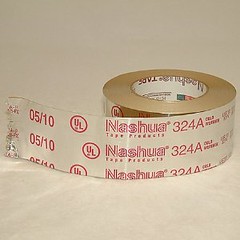Last week's Toolbox Tuesday covered a little hand tool that proved quite useful when doing some attic HVAC work. I was able to knock out the work pretty quickly because I had the right tools for the right job. But one of the most important aspects of the HVAC work I did was making sure it was fully sealed to prevent any air leaks. This week I want to use this opportunity to address something that causes much confusion and often results in mistakes among the inexperienced to very accomplished DIYer when they find themselves working on a project that involves HVAC ducting.
Duct Tape, no matter its name, has no place anywhere near your ducts.
How crazy is that? Why would anyone possibly assign a name to something that has no place being used on the thing it was named for?
Many people will state that duct tape is reliable, strong, efficient, readily available, and "can fix anything." But quite honestly, when it comes to duct work, the only thing reliable about duct tape is its consistency in failure. It may work fine at 200 mph when applied to NASCARs, but it will quickly fall apart when sitting still in your house.
For years now, competent DIYers have been applying duct tape to seal leaky air ducts. Hey, I'll admit it, I did the same thing very early on in our renovation before I learned the error in my ways, or at least the error in the ways of the marketers that misleadingly named the product.
Even a very well known DIY blogging couple recently fell victim to this manufacturer's naming ploy, allowing regular duct tape to grace their kitchen's new range hood exhaust. Luckily commenters noticed this and alerted them to the misstep and they were able to resolve it, no harm, no foul. My point being that nobody's immune, and it's a necessary lesson we all must learn.
Well, I'm here to do my part in ensuring the masses are informed. Ok, maybe not the masses, maybe just the handful of Old Town Home friends who aren't already aware of this subtle but critical tape distinction. Take a look at the work we completed last week. After connecting up the ducts and apply the adjustable clamps, I covered all possible gaps, seams, and joints with ample amounts of foil tape.
I also made sure to properly tape up that splice I had to make in the middle of the flexible duct.
So when you need to do some routine or major duct work, and you want to make sure your changes last, be sure to use premium foil tape and not a roll of your run of the mill duct tape. Foil tape is specifically made for adhesion and long lasting performance under the temperature variations that come with heating systems. Normal duct tape will dry out and deteriorate after just a few seasons of consistent heating or cooling use.You'll be saving yourself a fair amount of replacement and repair work down the road.
My foil tape of choice is Cold Weather Foil Tape. I've used this foil tape for the last eight years on any project that requires me to add, patch, or reconfigure duct work. I've used it to seal everything from pinhole leaks, to securing the edges of large patches. And best of all, I've gone back into the system years later for one reason or another and the tape is still in place, still holding strong, and still doing its job. You really can't ask for better performance.
In addition to the foil tape, there is a gooey mastic substance you can apply to the ducts that works quite well. Though it provides a great seal, I'm a little hesitant to use it in the tight spaces I've been working in due to the mess I'm sure I would cause. Thus far, I'm sticking with the foil tape, but if I have a change of heart, you'll be the first to know.
So now we know that you shouldn't use duct tape on your ducts, but there are many other creative uses for that product, like this one for instance.
So be honest, are you guilty of using duct tape on your ducts, or are you a savvy DIYer who was granted this tip early on in your projects? I wouldn't fault you for it if you have used it, I mean, it's called "Duct Tape." But in the immortal words of GI Joe and the cartoon I grew up watching..."Now you know... And knowing is half the battle!"
Did you enjoy reading this post? Want to learn more about our first-hand experiences with other tools, devices or items used throughout our renovation? If so, check out our complete list of product reviews in our Toolbox Tuesday section.
Note: We weren't compensated for this review. We simply want to share good products when we see them, and hope that learning from our mistakes can help save you time, money and frustration.

![]()
![]()